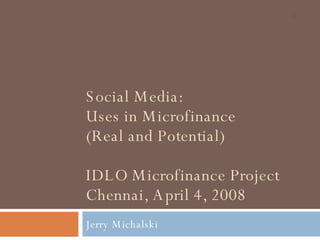0804 Idlo Chennai
- 1. Social Media: Uses in Microfinance (Real and Potential) IDLO Microfinance Project Chennai, April 4, 2008 Jerry Michalski
- 2. WhoŌĆÖs speaking 1987-1998 as a technology industry analyst Avocation ’āĀ vocation Identifying trends Bridging business, society and tech Famous boss (Esther Dyson) 1998-now: independent consultant ŌĆ£ Guide to the relationship economyŌĆØ Raised in Peru and Argentina Champion for ordinary people
- 3. Important context The dominant worldwide platform: Today: Calls, SMS, Web Remittances ( G-Cash ) Soon: Pictures Video Your bank Much more Sullivan: You Can Hear Me Now: How Microloans and Cell Phones are Connecting the World's Poor to the Global Economy Ask Aslam!
- 4. Our workshopŌĆÖs ŌĆ£tagŌĆØ isŌĆ” IDLO2008Chennai
- 5. IŌĆÖm using it already Memorable (yet private) Short Unique No permission needed Photos on Flickr Links on del.icio.us Videos on YouTube
- 6. What weŌĆÖll cover What is social media? Web 1.0, 2.0 (3.0?) More than a technological shift What opportunities does it offer? Fit with microfinance What organizations are doing What is now possible
- 7. Web ŌĆ£1.0ŌĆØ Web pages/sites Weblogs Wikis Email, mailing lists Instant messaging
- 8. Weblogs Component parts Posts Permalinks Comments Blogroll Useful microfinance blogs MicroCapital.org Acumen Fund blog Newest Post Blogroll Title
- 9. Wikis ŌĆ£ Wiki-wikiŌĆØ means ŌĆ£quickŌĆØ in Hawaiian Group editable websites Make page links [like this] Four examples Wikipedia (e.g., its page on microfinance ) TaxAlmanac.org (Intuit) BarCamp.org (ŌĆ£unconferencesŌĆØ) A site I set up for you (on a free service)
- 10. Web 1.0 communication tools Email, mailing lists Instant messaging (IM) Voice over IP (VoIP)
- 11. Web ŌĆ£2.0ŌĆØ More interactive More connected More social More open More complicated and unpredictable
- 12. Media sharing Photo sharing: Flickr (now part of Yahoo) Video sharing: YouTube (now part of Google) Link sharing: del.icio.us (now part of Yahoo) Document sharing: Google Docs Library sharing: Shelfari Event calendars: Upcoming (Yahoo also) ŌĆ” almost anything you can think of Two key features: tagging and social networking
- 13. Social networking sites All the sites on the previous page Facebook One personŌĆÖs profile And thousands of Facebook ŌĆ£appsŌĆØ MySpace Bebo Hundreds of others
- 14. ŌĆ£ MashupsŌĆØ HousingMaps.com ChicagoCrime.org ( arson ) digglicious (Digg + del.icio.us) ProgrammableWeb
- 15. New communication tools ŌĆ£ NanobloggingŌĆØ Twitter Lifestreaming FriendFeed ( mine ) Web conferencing FacebookŌĆÖs mini-feed
- 16. And more How-to 5min Life Videopedia Howcast Where to? PickupPal IsAnyoneGoingTo Market makers CellBazaar Tradenet
- 17. All add up toŌĆ” An ŌĆ£ architecture of participation ŌĆØ
- 18. Not just a technology shift Assume good behavior Let community fix bad behavior Costs have plummeted Power has shifted Emphasis on Social Open
- 19. Openness: a framework Open Source Open Content Open Process Mix and match
- 20. Mobs or collective intelligence? Mackay (1841): ŌĆ” the Madness of Crowds Hardin (1968): The Tragedy of the Commons Shirky: Here Comes Everybody Tapscott: Wikinomics Surowiecki: The Wisdom of Crowds Rheingold: Smart Mobs Benkler: Sharing Nicely
- 21. Persistence
- 22. All the stakeholders Other intŌĆÖl resources UN, NGOs, etc. Volunteer corps Global idea banks Supranational movements Government ministries Finance Development Central bank WomenŌĆÖs rights Global market makers Kiva MicroPlace Etsy Asia Europe The Americas Africa IDLO MNCs (banks) Apex Orgs (funds, accel.)
- 23. And more MFIs Their Families Health Education Knowledge Bias/access Housing Remittances Their Markets Demand Logistics Coordination Intermediaries Asia Europe The Americas Africa IDLO MNCs (banks) Apex Orgs (funds, accel.) Borrowers Lending Circles
- 24. Questions? Jerry Michalski [email_address] www.sociate.com +1 (415) 465-0256
- 25. Google Popdex Technorati Feedster The Blogosphere Wiki (1995) A Map Personal Home Pages Justin Hall (1994) Weblogs (1997) Search Engines RSS Feeds RSS Aggregators Ward Cunningham Other services Flickr del.icio.us Google Maps Mashups CamelCase CamelCase
- 26. A map of the trends









![Wikis ŌĆ£ Wiki-wikiŌĆØ means ŌĆ£quickŌĆØ in Hawaiian Group editable websites Make page links [like this] Four examples Wikipedia (e.g., its page on microfinance ) TaxAlmanac.org (Intuit) BarCamp.org (ŌĆ£unconferencesŌĆØ) A site I set up for you (on a free service)](https://image.slidesharecdn.com/0804-idlo-chennai-1207291741381357-9/85/0804-Idlo-Chennai-9-320.jpg)














![Questions? Jerry Michalski [email_address] www.sociate.com +1 (415) 465-0256](https://image.slidesharecdn.com/0804-idlo-chennai-1207291741381357-9/85/0804-Idlo-Chennai-24-320.jpg)

